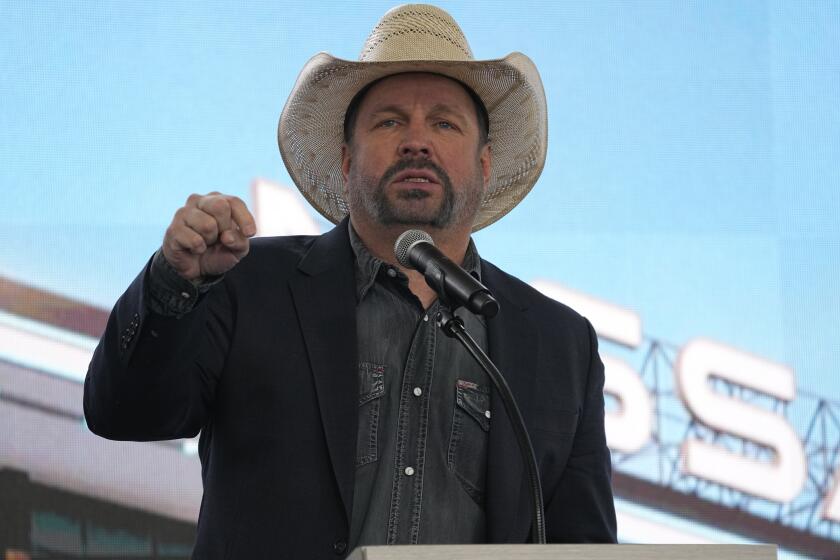Labelle was always more than a ‘Lady’
The METROPOLITAN Opera House in New York was invaded by aliens on Sunday, Oct. 6, 1974. A funky band replaced the orchestra that night; West Village drag queens sat next to Puerto Rican couples and Black Power glam rockers from uptown.
The crowd watched as two women -- wearing so many feathers they looked like birds -- descended from the rafters to join a third onstage. The trio’s harmonies were so close that their voices seemed to merge in a swirl of gospel, rock and soul.
This was Labelle in the mid-1970s. They were not just a pop group with one enormous hit, “Lady Marmalade,” but a phenomenon whose music helped change the very idea of what pop and the artists who made it -- especially women singers previously confined to “girl groups” -- could be.
“People were looking for three outrageous women who might sing and say anything,” said Patti LaBelle in a recent interview, reflecting on the emergence of the group she’d formed with Nona Hendryx and Sarah Dash when they were teenagers, and which has reunited for a new album, “Back to Now,” to be released Oct. 21 on Vanguard Records.
“The idea was for artists to sing what they live and write the songs they live. And we really treated it like a band, not a girl group,” said Hendryx. “Three minds, but one mind at the same time. And that did allow for different things to be said.”
During the mid-1970s Labelle stood alongside David Bowie and George Clinton’s P-Funk as visionaries of spectacular, genre-blasting pop.
“Alice Cooper and David Bowie, they were doing their thing,” Clinton said by phone from a spot on his current tour to promote his new project, the doo-wop flavored George Clinton and his Gangsters of Love. “That whole period, everybody was going for theatrical rock. So we just said, ‘Let’s go all the way with it. Let’s do it all.’ That’s what we did, and that’s what they were doing too.”
After spending the 1960s as the vocal group Patti LaBelle and the Bluebelles (who, among other accomplishments, toured with the Rolling Stones), the group guided by manager Vicki Wickham enacted one of pop’s most remarkable transformations. They traded in their wigs and satin gloves for futuristic costumes by rock designer Larry LeGaspi, began recording Hendryx’s politically forthright and erotically charged songs, and developed a stage show that was part gospel revival, part circus, part love-in.
They refashioned “Moonshadow” by Cat Stevens into a gospel stomp and opened for the Who -- “Back to Now” includes one cut from the vaults, a cover of Cole Porter’s “Miss Otis Regrets” featuring Keith Moon on drums. They recorded an album with Laura Nyro and followed Bette Midler’s famous engagement at New York’s gay mecca the Continental Baths.
“It wasn’t really accepted that black girls could sing these songs,” said Wickham, who also managed Dusty Springfield, from New York. “A lot of Nona’s songs had double entendres, it wasn’t like radio was going to jump on it. The time really wasn’t right, but I also think that we were so big on doing it live and having great audiences that nobody really said, ‘Hang on a second, you need to have something that goes on radio.’ ”
The Labelle legacy
“Nightbirds,” Labelle’s masterpiece, was recorded in New Orleans by that city’s maestro, Allen Toussaint. “Lady Marmalade” is its signature tune, and remains a touchstone for young singers. The group’s practice of sharing lead vocals was taken up by later female groups such as En Vogue and Destiny’s Child, and solo artists including Fantasia and Christina Aguilera cite Patti LaBelle as an influence.
But the legacy of Labelle, the band, might be coming to the fore only now, as category-defining artists such as Gnarls Barkley and Santogold revive the legacy of black rock. Lenny Kravitz, an early adapter of that sound, produced several tracks on “Back to Now.”
“In America more than other places, when you don’t put something in a nice, neat box and label it and put a ribbon on it, it’s hard for people to grasp,” Kravitz said by phone from Paris, where he lives part time. “All the years I was trying to get a record deal I kept hearing, ‘It’s not black enough’ or ‘It’s not white enough.’ That’s the same thing with Labelle.
Kravitz had planned to helm the whole project, but his touring schedule interfered. So the group turned to other producers, including Wyclef Jean (whose “Roll Out” is a cheerful attempt to adjust the Labelle sound for the auto-tuned era) and Patti’s childhood friend Kenneth Gamble, who, with his partner Leon Huff, originated the forward-thinking Philly soul sound embodied by artists like the O’Jays. Their “Tears for the World” provided Labelle with a 21st century anthem -- and Patti with the album’s most stunning vocal high note.
Gamble and Huff had worked with the trio on “Gonna Take a Miracle,” a 1971 collaboration with Laura Nyro. Labelle, Gamble said in a phone interview, symbolizes a historic cultural shift: “People were really starting to feel free to respect themselves more. Labelle was part of that transition.”
In 1974, possibilities seemed endless, both in pop and in human relationships. Even in that context, Labelle was unbound. “Back to Now” taps into the sound and spirit that made the trio unique. Perhaps now Labelle, so much more than a one-hit wonder, will no longer be hidden in plain sight.
As tight as LaBelle, Hendryx and Dash remain after four decades of friendship, they are very different women. LaBelle (whose birth name is Holt; the group made the “B” in her stage name lower-case) is everybody’s mama, famous for her cookbooks and wig line as well as her powerhouse vocals. But her touring and recording schedule delayed this reunion for several years.
She’d avoided Labelle’s albums since the group had disbanded. “Once I finish a project I don’t listen,” she explained. “It’s a wrap. A few years ago, I was forced to listen; someone was playing Labelle in the car. I said, ‘Damn, we’re hot!’ I realized how different we were. And we weren’t turning people off; we were turning people on.”
Asked what she gets from a Labelle reunion, she made a characteristically sassy joke. “I don’t have to sing lead all night. Take the weight off Fanny!” she said, paraphrasing a lyric from the Band’s song “The Weight.” “Let Patti lay back on the piano and drink some water; let Sarah and Nona work.”
But she also spoke emphatically about Hendryx’s songs.
“It offers me the writing of Nona Hendryx, who is totally overlooked as one of the greater writers today. She always writes with me in mind.”
LaBelle’s solo career is the elephant in Labelle’s room. The trio split partly because Labelle missed singing big ballads like “Over the Rainbow,” still a highlight of her live shows. Her subsequent hits made her a staple of black-oriented “quiet storm” radio, and though her live audience remains diverse, her superstar status is in the black-pop world.
“Patti LaBelle is a household name,” said David Nathan, co-owner of the site soulmusic.com, who’s known the group since the 1970s. “Americans know who she is. But if you ask most music buyers to name a Patti LaBelle solo hit, they can’t. Black audiences can. But that’s part of the nature of America.”
Hendryx and Dash took different paths. “I’m always the fixer in our harmonies,” Dash explained of her role in Labelle. “I will fall in and cover where they’re not.” This gift for blending made Dash an ideal voice for the big arrangements of disco, and she worked with producers like Sylvester’s partner Patrick Cowley and Jellybean Benitez; she also toured with the Rolling Stones and recorded with friend Keith Richards.
Hendryx, whose songwriting was inspired by a long list of countercultural heroes -- in an e-mail, she mentioned Henry Miller, Ram Dass and Angela Davis alongside Nina Simone, Nikki Giovanni and Gil Scott-Heron -- maintained her border-crossing ways.
She worked with Peter Gabriel, the funk-punk band Material, Prince and Talking Heads. Her own solo output, ranging from electro-tinged club hits to New Age experiments to musical theater, is as intriguing as it is overlooked.
Hendryx and Dash have stayed busy, but coming back to Labelle will increase visibility for both. The group, which has reunited for one-offs on rare occasions, plans to tour, though nothing is scheduled.
For Patti LaBelle, who’s continued to enjoy chart success and venues packed with screaming fans, the motivation might be more emotional.
It’s also a way to correct the misperception that Labelle begins and ends with “Lady Marmalade.” Asked if that song, which was written by the songwriting team of Kenny Nolan and Bob Crewe, ever felt like a burden, Dash guffawed.
“Not to me,” Dash declared. “It takes care of a lot of burdens when I need those burdens handled!”
“And it’s a great song,” added Hendryx. “If not for that one song you probably wouldn’t be sitting here talking to us.”
--
More to Read
The biggest entertainment stories
Get our big stories about Hollywood, film, television, music, arts, culture and more right in your inbox as soon as they publish.
You may occasionally receive promotional content from the Los Angeles Times.










